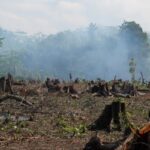We explain what an extinct species is, what the mass extinctions in history were and examples of extinct and protected species.

What is an extinct species?
When we refer to an extinct species, we do so to one whose last individuals have died, that is, to a species that no longer exists and of which only traces remain in the fossil record or in the studies that humanity has made of it.
The extinction It is a common phenomenon throughout the history of our planet although it may not seem like it. There have been various episodes of mass extinction that have reduced the quantity and diversity of world life, as well as others of smaller magnitude or local area, and isolated cases of species that have become extinct, giving way to others better prepared for exploitation. of resources.
The most famous case of extinct species is that of dinosaurs: lizards of enormous size that ruled the Earth until 65 million years ago, when they became massively extinct; probably as a consequence of drastic and rapid changes in global climate or temperature, which according to some theories would have been produced by the fall of a huge meteorite.
However, species continue to become extinct even today especially due to actions and activities of the human species such as massive environmental pollution, selective and uncontrolled hunting and logging, the introduction of foreign species into carefully balanced habitats, etc.
See also: Exotic species
Mass extinctions in history

Throughout the geological history of the planet, life appeared, proliferated and diversified becoming more complex, but it also perished and became extinct en masse. The main mass extinction events according to the fossil record were five:
- Ordovician-Silurian extinctions. It occurred 439 million years ago, which ended 85% of life at the time.
- Devonian-Carboniferous extinction It occurred 367 million years ago, which wiped out 82% of life on the planet.
- Permian-Triassic extinction. The worst of all mass extinctions, which occurred 251 million years ago and wiped out 96% of life in the world.
- Triassic-Jurassic extinction It took place 210 million years ago, as a consequence of the fragmentation of Pangea, and ended 76% of life at the time.
- Cretaceous-Paleogene extinction. Occurring 65 million years ago, it wiped out 75% of biological genera, especially dinosaurs.
Threatened species
Ecology speaks of threatened species to refer to those that seem likely to become extinct in the near future. That is, those species that classify, within the NUIC Red List of Threatened Species, the groups of Vulnerable Species (VU), Endangered Species (EN) and Critically Endangered Species (CR), according to an order from lowest risk to highest.
The criteria to evaluate the status of a species in this sense are based on the number of mature individuals that the species has as well as the rates of decrease in the number of total individuals (biomass) recorded during the last 10 years or the last 3 generations of individuals.
Protected species

There is a set of species protected by international ecology organizations, which expressly prohibit their hunting, capture, possession or even the destruction of their habitat given that they are generally species threatened with extinction. This is part of the efforts of numerous conservation organizations that try to prevent the total and definitive disappearance of these animal and plant species, thus defending the legacy of global biodiversity, that is, the variety of animal species that exist on the planet.
Some protected species are the Panda Bear (Ailuropodamelanoleuca), the black vulture (Aegypiusmonachus), the Mediterranean seal (Monachusmonachus) and the Iberian lynx (Lynx pardinus).
Examples of extinct animals

Some animals extinct due to their contact with the human species are:
- The Dodo or Dronte bird (Raphuscucullatus) A very docile species of flightless land bird, which inhabited the Mauritius Islands, and whose absence of predators made it excessively vulnerable to the arrival of the human species, which hunted it to extinction at the end of the 17th century.
- The Mexican grizzly bear (UrsusarctosNelson) A subspecies of brown bear that inhabited the Mexican states of Durango, Chihuahua, Sonora and central Mexico, and whose last specimen was hunted by Nutal HA Cluff in 1899.
- The Japanese sea lion (Zalophusjaponicus) whose habitat was the Japanese archipelago until the bombings of World War II wiped out the species. The last specimen of the species was captured in 1974.
- The Javan Tigerpanthera tigerprobe) A subspecies of tiger from the Indonesian island of Java, which since 1994 has been assumed extinct.
- The Baiji dolphin (Lipotesvexillifer). Also called the Chinese river dolphin, it lived in the Yangtze River, thanks to which it was nicknamed the “widow of the Yangtze.” Its last specimen was sighted in 2007 and in 2008 it was declared extinct.
- The Galapagos tortoise (Chelonoidisnigra) An immense tortoise from the Galapagos Islands of Ecuador, capable of living hundreds of years, disappeared with the death in 2012 of “George”, its last known living specimen.
References
- “Extinction” on Wikipedia.
- “Extinction” in the National Commission for the Knowledge and Use of Biodiversity (Mexico).
- “Species in extinction” in Ecologists in action.
- “17 animals that became extinct in the last 50 years” in Ecoosfera.
- “Extinct species” in National Geographic.





